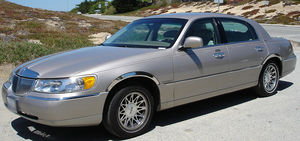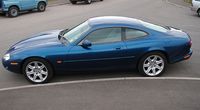.
Car classification: Difference between revisions
No edit summary |
No edit summary |
||
| Line 1: | Line 1: | ||
'''Car classification''' is subjective since many vehicles fall into multiple categories. Not all car types are sold in all countries and names for the same vehicle can differ by region. The following are commonly used classifications within [[Wikipedia]]. Where applicable, the relevant [[EuroNCAP]] classifications are shown. Please note that the car classifications (A, B, C or D) given in this article are not the same as insurance classifications. | '''Car classification''' is subjective since many vehicles fall into multiple categories. Not all car types are sold in all countries and names for the same vehicle can differ by region. The following are commonly used classifications within [[Wikipedia]]. Where applicable, the relevant [[EuroNCAP]] classifications are shown. Please note that the car classifications (A, B, C or D) given in this article are not the same as insurance classifications. | ||
<ref>[http://www.wcsauto.com/salvage/categories/index.html Insurance salvage categories]</ref> | <ref>[http://www.wcsauto.com/salvage/categories/index.html Insurance salvage categories]</ref> | ||
{{Automobile classification}} | |||
==Microcar== | ==Microcar== | ||
Revision as of 22:17, 20 September 2009
Car classification is subjective since many vehicles fall into multiple categories. Not all car types are sold in all countries and names for the same vehicle can differ by region. The following are commonly used classifications within Wikipedia. Where applicable, the relevant EuroNCAP classifications are shown. Please note that the car classifications (A, B, C or D) given in this article are not the same as insurance classifications. <ref>Insurance salvage categories</ref>
Microcar
Straddling the boundary between car and motorbike, these vehicles have engines under 1.0 liter, typically seat only two passengers and sometimes unorthodox in construction. Some microcars are three-wheelers, while the majority have four. Microcars can be associated with post-war Europe, where their appearance led them to be called Bubble cars. A contrast to the traditional microcar is the modern Smart Fortwo.
Examples of microcars:
Hatchbacks, sedans and station wagons
City car
A city car is a small automobile intended for use in urban areas. Unlike microcars, a city car's greater speed and occupant protection are safer in mixed traffic environments and weather conditions. While city cars can reach highway speeds, that is not their intended use. In Japan, city cars are called kei cars. Kei cars have to meet strict size and engine requirements: engines have a maximum displacement of 660 cc and the car's length must be under 3400 mmm.
Examples of kei cars:
Examples of city cars:
Supermini / Subcompact car
This class is known as supermini in Europe, subcompact in North America and light car in Australia. These vehicles are the smallest cars sold in the North America. Superminis have three, four or five doors and are designed to seat four passengers comfortably. Current supermini hatchbacks are approximately 3900 mm long, while sedans and station wagons are around 4200 mm long.
In Europe, the first superminis were the Fiat 500 of 1957 and the Austin Mini of 1959. Today, superminis are some of the best selling vehicles in Europe.
Examples of superminis / subcompact cars:
This category is equivalent to the EuroNCAP class 'Superminis'.
Small family car / Compact car
Compact cars refer to the longest hatchbacks and sedans and station wagons with similar size. They are approximately 4250 mm long in case of hatchbacks and 4500 mm in the case of sedans and station wagons. Compact cars have room for five adults and usually have engines between 1.6 and 2.2 liters. These are the most popular vehicles in most developed countries.
Examples of hatchback small family cars / compact cars:
This category is equivalent to the EuroNCAP class 'Small Family Cars'.
Large family car / Mid-size car
Mid-size cars have room for five adults and a large trunk. Engines are more powerful than compact cars and six-cylinder engines are more common than in smaller cars. Car sizes vary from region to region; in Europe, large family cars are rarely over 4700 mm long, while in North America and Australasia they may be well over 4800 mm.
Examples of large family cars / mid-size cars:
This category is equivalent to the EuroNCAP class 'Large Family Cars'. These are known in Australia as medium cars.
Full-size car
These term is used most in North America and Australia where it refers to the largest sedans on the market. Full-size cars may be well over 5000 mm long and are the roomiest vehicles.
Examples of full-size cars:
Compact executive car / Entry-level luxury car
These are luxurious equivalents to large family cars and compact cars. Powerful six- and eight-cylinder engines are common, but rear seat room and trunk space are more reduced than in "non-luxury" models since the extra room is needed to accommodate the larger engine.
Examples of compact executive cars / entry-level luxury cars:
This category is equivalent to the EuroNCAP class 'Large Family Cars'.
Executive car / Mid-luxury car
An executive car or mid-luxury car is larger than a compact executive car/entry-level luxury car. They are usually very roomy, powerful and luxurious, making them more expensive than "standard" sedans.
Examples of executive cars / mid-luxury cars:
This category is equivalent to the EuroNCAP class 'Executive Cars'.
Full-size luxury car
A full-size luxury car is typically a four-door sedan. These are the most powerful sedans, with eight and twelve-cylinder engines and have more equipment than smaller models.
Examples of full-size luxury cars:
This category is equivalent to the EuroNCAP class 'Executive Cars'.
Sports cars and grand tourers
Hot hatch / sport compact
A hot hatch or sport compact is a high-performance small car, usually a hatchback, based on standard superminis or small family cars with improved performance, handling and styling. Hot hatches are very popular in Europe. In North America, sport compacts are usually sold as sedans or coupés rather than hatchbacks.
Examples of sport compacts:
Examples of hot hatches:
Sports sedan / sports saloon
These are high performance versions of sedans. Originally homologated for production based motorsports (touring cars) and like regular sedans, seats four or five people.
Examples of sports sedans / saloons:
Sports car
This small lightweight class combines performance and handling. Often inspired by racing vehicles, this class ranges from sporty vehicles such as the Mazda Miata/MX-5 to derivatives of true racing thoroughbreds such as the Lotus Elise.
Examples of sports cars:
Grand tourer
Larger, more powerful and heavier than sports cars, these vehicles typically have a FR layout and seating for four passengers (2+2). These are more expensive than sports cars but not expensive as supercars. Some grand tourers are hand-built.
Examples of grand tourers:
Supercar
Supercars are ultra-high performance cars, typically very expensive, luxurious and exceptionally fast. Supercars typically contain cutting-edge technology and are usually assembled by hand.
Examples of supercars:
- See also: List of supercars
Muscle car
The Muscle car term was coined in United States. Classic muscle cars appeared in the mid-1960s and disappeared because of the 1973 energy crisis. Muscle cars became popular in Australia during the 1980s. These cars shoe-horned giant engines into mid-sized cars straight from the factory. Handling took a backseat to straight-line acceleration.
Examples of American muscle cars:
Examples of Australian muscle cars:
Examples of Japanese muscle cars:
Convertible
Also called an open saloon, roadster or drop-head coupe, this type of car has a roof (fabric, vinyl, metal or glass) which can be folded away. Convertibles were very popular in hotter places before the advent of automotive air-conditioning. 2-seat convertible sports cars are commonly named roadster or spyder.
Examples of convertibles:
Off-roaders
Sport utility vehicle
Sport utility vehicles are off-road vehicles with a body-on-frame chassis, four-wheel drive and true off-road capability. SUVs can be troublesome in accidents. A high center of gravity gives SUVs means SUVs rollover more easily than automobiles.
Examples of 4x4s / SUVs:
This category is equivalent to the EuroNCAP class 'Large Off-Roaders'.
Crossover SUV
Crossover SUVs have a monocoque construction and lower ground clearance than SUVs. Some of them have traction control and adjustable suspension to improve off-road capabilities.
Examples of crossover SUVs:
This category is equivalent to the EuroNCAP class 'Small Off-Roaders'.
Minivans / Multi-purpose vehicles
Also known as people carriers, this class of cars resemble tall station wagons. Larger minivans may have seating for up to eighth passengers.
Being taller than a family car improves visibility for the driver (while reducing visibility for other road users) and may help access for the elderly or disabled. They also offer more seats and increased load capacity than hatchbacks or station wagons.
Examples of mini MPVs:
Examples of compact MPVs:
Both categories are equivalent to the EuroNCAP class 'Small MPVs'.
Examples of large MPVs / minivans:
This category is equivalent to the EuroNCAP class 'MPVs'.
Van
In some countries, the term 'van' can refer to a small panel van based on a passenger car design (often the station wagon / estate model); it also refers to light trucks, which themselves are sometimes based on SUVs or MPVs. (But note that those retaining seats and windows, while being larger and more utilitarian than MPVs, may be called 'minibuses'.) The term is also used in the term 'camper van' — equivalent to a North American recreational vehicle.
In the United States, the term 'van' refers to vehicles that, like European minibuses, are even larger than large MPVs and are rarely seen being driven for domestic purposes — except for 'conversion vans'. These possess extremely large interior space and are often more intended for hauling cargo than people. Most vans use body-on-frame construction and are thus suitable for extensive modification and coachwork, known as conversion. Conversion vans are often quite luxurious, boasting comfortable seats, soft rides, built-in support for electronics such as television sets, and other amenities. The more elaborate conversion vans straddle the line between cars and recreational vehicles.
Examples of North American 'vans':
Examples of European 'vans':
See also
References
<references/>


